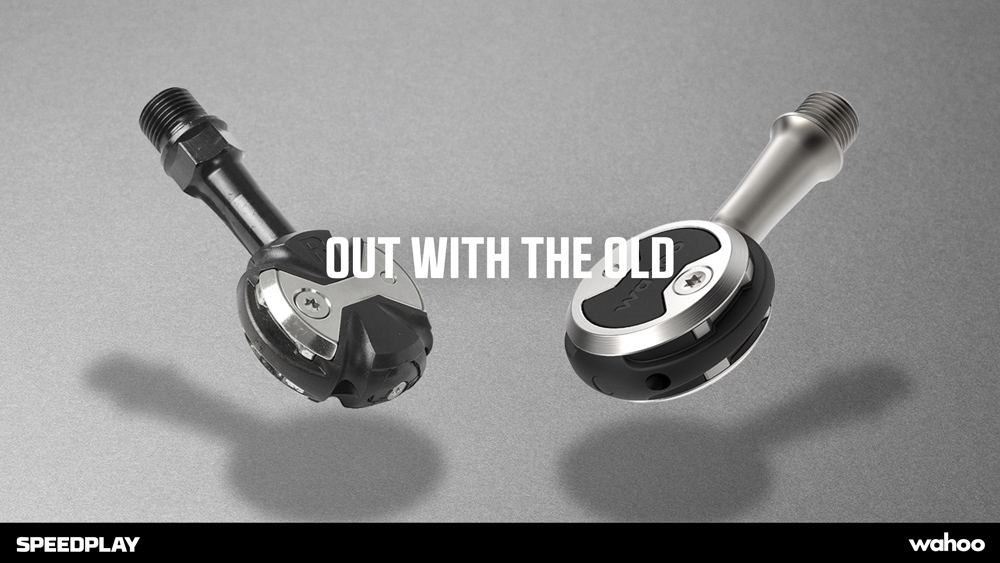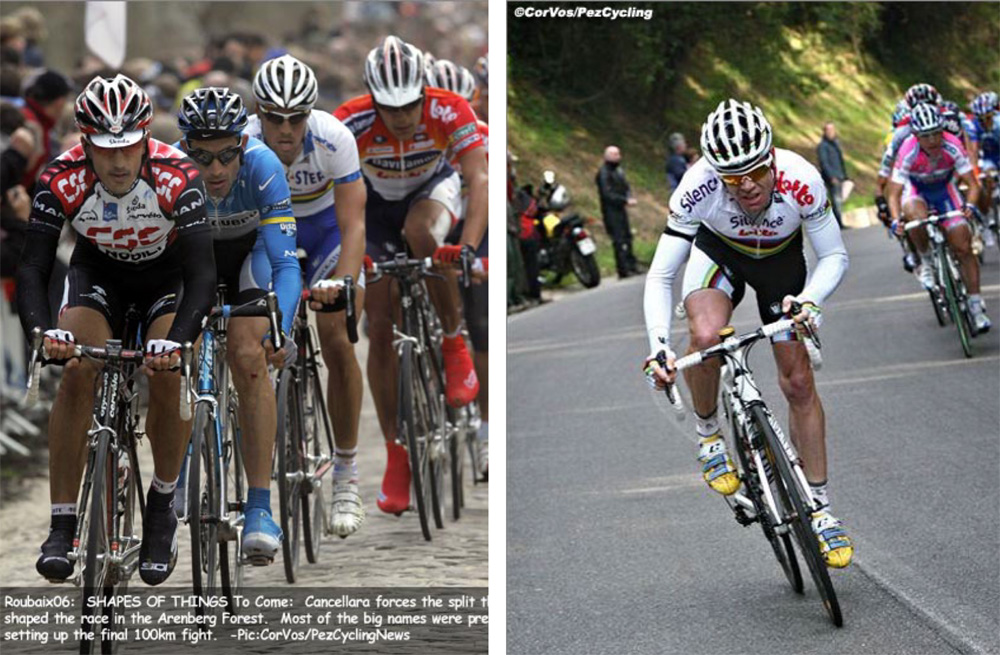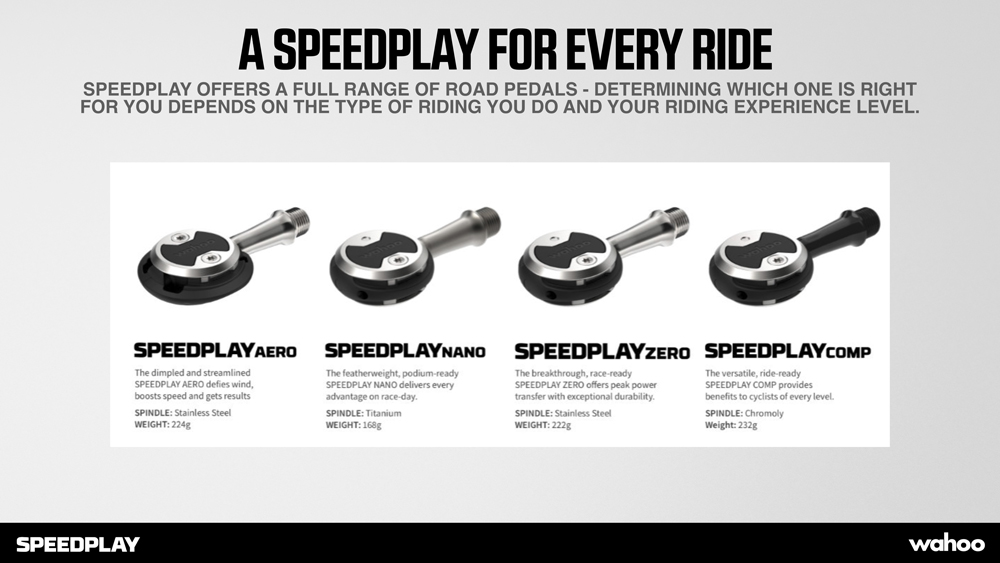Wahoo Speedplay Zero Pedals Review: New Version of an Old Favorite
Both different and the same.
In what was considered by many in the bicycle industry as a bit of a surprise, Wahoo acquired Speedplay in September 2019. Those of us riding Speedplays have been waiting with bated breath to see what Wahoo would do. The wait is over and we’ve had time to ride and review the updated Wahoo Zero Speedplay pedals.

A Little Bit of History

The Wahoo incarnation of the venerable Speedplay pedal
The original Speedplay X pedal was patented by Richard Byrne in 1989 and he founded the company in 1991. Compared to every other clipless pedal of the time (and still pretty much true today), the Speedplay X pedals were very different:
- The round “lollipop” platform allowed for dual-sided entry. And entry was relatively easy by just by stepping down into the cleat whether the pedal was right side up, upside down or anywhere else in its rotation. No kicking, no fumbling, no looking; just step down and go.
- The locking mechanism for the pedal didn’t rely on spring tension which made entry easy but made unintended release virtually impossible.
- Not needing spring tension to hold the cleat in place allowed for total free float of your foot on the pedal. This lateral float was claimed to be easier on your knees.
- The compact, low-profile shape of the X pedals positioned your foot closer to the spindle for more efficient power transmission and very high cornering clearance.

If it’s a lollipop, it must be a Speedplay
Speedplay pedals became an immediate hit on the local crit scene. They were also sought after by weight weenies (less than 200 grams per pair). And they’ve been ridden to victory in the Tour de France, Giro d’Italia, Olympics, World Championships, Paris-Roubaix, Tour of Flanders, Gent Wevelgem, Flèche Wallonne, and Strade Bianche (as well as the Ironman triathlon). So while not as ubiquitous as Look pedals, they have palmarès.

Yup, those are nearly 30 year old Speedplay pedals on my otherwise thoroughly modern Colnago.
I’ve been riding the original Speedplay X pedals (I have 4 pairs including the ones on my wife’s bike) since my racing days in the early 90s — including on my recent Colnago V3 PEZ project bike. To say that I love the Speedplay X pedals would be an understatement. They’re a total no-brainer to clip in. I don’t know that my knees actually need the free float, but it’s comfortable and just seems natural to me. And clipping out them is nearly effortless (which comes in handy when confronted with an unexpected/emergency situation that requires unclipping tout de suite).

Now being ridden by EF-Education NIPPO on the men’s side and Canyon/SRAM and Alé BTC Ljubljana on the women’s side. Two other guys who’ve ridden Speedplay pedals: Spartacus aka Fabian Cancellara and TdF winner and road race World Champion Cadel Evans
The New Speedplay by Wahoo

Previously, Speedplay had the X Series, Ultra Light Action, and Zero (read the PEZ review of the Zero here) road pedals with different variants (e.g., spindle material, spindle length; in the case of the Zero, an aero pedal that was single-sided entry used by Bradley Wiggins when he rode the then UCI World Hour Record of 54.526 km on June 7, 2015, the Pavé version ridden by Fabian Cancellara to victory in Paris-Roubaix in 2006, and the ultralight — 130 grams per pair — Nanogram that used a carbon fiber in the pedal body). In many respects, the array of choices was a little confusing/bewildering for consumers — especially since there wasn’t cleat compatibility across the different pedals.

All the bits that come with the pedals: top (l-to-r) fastening screws for the base plates and cleats and extra shims for the base plates; bottom (l-to-r) walkable cleats with aero covers, base plates with shims plus cleat surrounds.
Wahoo decided to simplify things with four different models of the same familiar Speedplay “lollipop” pedal platform design:
- Comp (chromoly spindle, 116 grams per pedal, $149.99)
- Zero (stainless spindle, 111 grams per pedal, multiple spindle length options, $229.99) – what PEZ received
- Nano (titanium spindle, 84 grams per pedal, $449.99)
- Aero (stainless spindle, 112 grams per pedal, single-sided entry, $279.99) – one side of the pedal has a dimpled cover that integrates with the cleat for smoother air flow


My Zeros tipped the scales 1 gram lighter than spec’ed weight
There are two cleat options: Standard Tension and Easy Tension. Both are compatible with all four pedals (Standard Tension Cleats are included with Aero, Nano, and Zero; Easy Tension is included with Comp). NOTE: The cleats are essentially the same as the previous Speedplay Zero Aero Walkable cleats. That means if you have those cleats on your shoes, you can use them with the new Wahoo Speedplay pedals (the older non-walkable Speedplay Zero cleats will also work with the new Wahoo Speedplay pedals). No other legacy Speedplay cleats (like my X-Series) are compatible with the Wahoo Speedplay pedals. Conversely, the new Speedplay Wahoo cleats are backwards compatible with older Speedplay Zero pedals, but no other older Speedplay pedals..

Speedplay Zero is just slightly different, but still a lot the same
At first glance, the new Wahoo Speedplays look a lot like the old Speedplays. Meaning they both have the same round pedal platform. But gone is the the metal “bowtie” that attaches to the pedal body. Instead, the pedal body is metal that surrounds a black bowtie “cutout.” Visually, it’s sort of a reverse effect. NOTE: I didn’t disassemble the new Speedplay pedals to see what they’re all about design/construction-wise.

The family resemblance is apparent: original Speedplay X (left) and the new Wahoo Speedplay Zero (right)
Also different is that the new Wahoo Speedplay pedals don’t have wrench flats. Instead, you use an 8mm hex wrench (the Nano with titanium spindle uses a 6mm hex wrench) on the hollow inside of the spindle on the threaded end to snug the pedals in place. But without pedal flats (that usually have L and R stamped on them), how do you know which pedal is which? Well, when the pedals are laid flat, the “wahoo” logo reads left-to-right to identify which pedal goes where. Genius!

8mm hex wrench to snug the pedals in place
Another difference is the bearings. Old Speedplays (like my X2s) had serviceable/replaceable cartridge bearings. The new Wahoo Speedplays have maintenance-free sealed cartridge bearings.

Which pedal is the left pedal? The one where you can read “wahoo” left-to-right.
Functionally, however, the new Wahoo Speedplay pedals are the same. That means, the same dual-sided entry. The same no-spring-tension locking mechanism. The same pedal float (since the new Wahoo Speedplay is based on the Zero, that means adjustability within a 15 degree range versus the total free float of my X Series pedals). The same high cornering clearance. In other words, all the things that made Speedplay pedals Speedplays.

The cleat spring slots into a groove on the front and back of the pedal body (there are two sets of grooves so you can clip in from either side) and locks onto the pedal without tension to hold the cleat in place
Cleats
For PEZ readers new to Speedplay, attaching the cleats is a little bit different because Speedplay cleats use a 4-hole mounting system. It’s not difficult but involves a few more steps than just mounting a 3-hole cleat.
The first thing to do is screw the base plate to the outsole of the shoe. Two things to note:
- The Speedplay base plate has two shims pre-installed at the front and back. Since the base plate is flat, the shims are used help conform the base plate to the shape of the sole. Also included are a second set of shims. Per Wahoo: “The base plate/shim combo may not create a ‘perfect’ fit to the bottom of the shoe, but for the best results it is important to use the shims that provide the ‘best’ fit.”
- Adjust the base plate fore/aft position the same way you would for a 3-hole cleat.

Use the shims to fit the base plate to shoe sole

Base plate in place
Then fit the cleat surround around the base plate.

The cleat surround integrates with the walkable aero cleat cover

The Speedplay Zero cleat consists of two parts: (left) the protector plate and (right) spring and housing
The protector plate is pre-assembled to the spring and housing (they can be easily separated and put back together). Screw the assembly, i.e., the cleat, onto the base plate using a “double-x” pattern: top left, bottom right, top right, bottom left. Adjust the cleat left-right to the desired position (NOTE: this is likely a trial-and-error process — I started with the cleat centered and then moved it based on how my foot felt on the pedal when clipped in and pedaling) and tighten the screws (NOTE: Wahoo’s recommended tightening torque is 2.5 Nm but I didn’t have a torque screw driver so just tightened as far as I could hand tight).

Cleat in place
Adjust the limit screws for the desired range of float. In my case, that meant backing them out for as much float as possible so that it was as close as possible to the total free float of my Speedplah X pedals. But you can fine tune how much “heel in” and “heel out” float. Or you can set the cleat up in a fixed position of your choice within the range of adjustment.
Finally, fit the walkable cleat cover to the cleat (specifically, the protector plate) so that it’s flush with cleat surround (make sure it’s on properly because otherwise you risk having it fall off when you unclip/walk). Voila!

These shoes aren’t made for walking, but the cleat covers make them coffee shop walkable
To make it easier to clip in and out of the pedals, Wahoo recommends spraying some dry lube on the cleat spring (something I’ve always done with my Speedplay X2s). Just remember to wipe away any excess lube so you don’t end up slipping and sliding when you walk.

Make sure the cleat covers are pushed on tightly so that they’re flush with the cleat surrounds
NOTE: Several shoe manufacturers make Speedplay-specific 4-hole shoes that make it straightforward to mount Speedplay cleats, but none of my shoes are this version. In addition to making it easier to mount Speedplay cleats, not needing the 3-hole adaptor plate means a lower stack height — positioning your foot some 3 mm closer to the top of the spindle for improved power transfer. #marginalgains
Not fixing what ain’t broken

Coming from the Speedplay Xs, the new Wahoo Speedplay Zeros aren’t exactly the same from a “feel” standpoint. My Speedplay Xs are super easy to clip in and out of and the float feels buttery smooth. By comparison, the Wahoo Speedplay Zeros feel stiffer/firmer. They require noticeably more force to clip in and click out of. I felt like I had to place more of my weight onto the pedal to clip in. Clicking out required more conscious thought/effort to exert outward force. I could also feel the “hard stop” of the heel out float limit when clicking out (with the Speedplay X, it’s just continuous, smooth, and effortless float as I turn my ankle out until the cleat releases from the pedal).
These aren’t knocks against the new Wahoo Speedplay pedals. Simply statements of fact based on comparison to my old Speedplay X pedals. It’s not a question of better or worse — just different. I don’t have experience riding the previous Speedplay Zero pedals, but I’m guessing the new Wahoo Speedplay Pedals feel a lot the same as the old Zeros since they’re essentially the same retention and float design.

To avoid mixing them up with the Standard Tension cleat, the Easy Tension cleat is gray
It’s worth noting that the Wahoo Speedplay Zero pedals ship with the Standard Tension cleats (ditto for the Nano and Aero). The Easy Tension cleats ship with the Comp, but are also available separately and I was able to try them for comparison. (NOTE: The Easy Tension cleats don’t include the base plate surround piece.) The difference between the two cleats was noticeable. Much less effort was required for both entry and exit with the Easy Tension cleat. It’s important to note that “easy” is a relative term. I was still firmly attached to the pedals with the Easy Tension cleats and in no fear of easily clipping out by accident. But the ease of entry and exit was much closer to my X2 pedals/cleats, so it’s the Easy Tension Wahoo Speedplay cleats pour moi.

I’m glad I had the Standard Tension cleats with the surround around the base plate for a more “complete” look/aesthetic with the Easy Tension cleats — not that anyone would necessarily see or notice
From an actual pedaling standpoint, the new Wahoo Speedplay pedals felt exactly the same as my old Speedplay X2 pedals. With it being the tail end of winter, most of my riding on the Wahoo Speedplay Zeros so far has been indoors on my Wahoo KICKR Axis (although I’ve managed a couple 20-ish mile rides and a 40+ mile ride outdoors). But whether it’s on Zwift, the Sufferfest, RGT, or Xert, and whether I’m spinning at higher RPMs, grinding away out of the saddle, or giving it my best effort to sprint, the shoe-to-pedal connection feels sure and comfortable and I’m able to put down the prescribed watts (and if I can’t, it’s not the pedal’s fault).

If you’re in the market for new pedals and need float to ease the stress on your knees, that’s the signature feature of Speedplay pedals that continues with the new Wahoo Speedplay. But even if you don’t need the float (which can be dialed out to make it a fixed position), Speedplay pedals have a lot to offer: easy dual-sided entry, light weight, high cornering clearance. And if you’re a longtime Speedplay jockey (like me), the new Wahoo Speedplay pedals are a nearly seamless replacement. What Wahoo have managed to do is take an already excellent existing product with a proven track record, update it to make it new, and yet keep it familiar. That’s about as good as it gets to not fixing what ain’t broken.

What’s the opposite of bird’s eye view?
A final bit of news about the new Wahoo Speedplay pedals: Wahoo is excited to announce the world’s first dual-sided, pedal-based power meter. The highly anticipated POWRLINK ZERO will be available in the summer 2021. Wahoo indeed!
• See more info at the Wahoo website here.
Note: If you have other experiences with gear or something to add, drop us a line. We don’t claim to know everything (we just imply it at times). Give us a pat on the back if you like the reviews or a slap in the head if you feel the need!
PezCycling News and the author ask that you contact the manufacturers before using any products you see here. Only the manufacturer can provide accurate and complete information on proper/safe use, handling, maintenance, and or installation of products as well as any conditional information or product limitations.



Comments are closed.